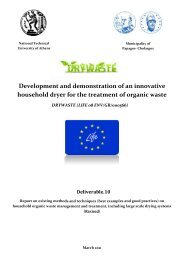MOROCOMP (LIFE TCY05/MA000141) - Unit of Environmental ...
MOROCOMP (LIFE TCY05/MA000141) - Unit of Environmental ...
MOROCOMP (LIFE TCY05/MA000141) - Unit of Environmental ...
You also want an ePaper? Increase the reach of your titles
YUMPU automatically turns print PDFs into web optimized ePapers that Google loves.
This will limit the movement <strong>of</strong> air and lead to anaerobic conditions. Moisture content<br />
should be above 40% at the starting point, as it will generally decrease as composting<br />
proceeds. Therefore if the moisture content falls below 40%, water should be added to<br />
maintain optimum conditions.<br />
During composting the moisture levels change as water evaporates and usually there<br />
is a need for water addition. In many composting cases more water evaporates than is<br />
added so the moisture tends to decrease as the composting proceeds. Moisture levels<br />
should be maintained so that materials are thoroughly wetted but without being<br />
waterlogged.<br />
The moisture content range <strong>of</strong> 40-65% works well for most materials. The upper limit<br />
for moisture content is dependent on the absorbency and porosity <strong>of</strong> the raw materials.<br />
A mixture with highly absorbent materials (e.g. dry grass) may need to be maintained<br />
well above 40% moisture in order to support rapid decomposition. Materials should<br />
not be allowed to dry out below 40% moisture content, as this will increase the chance<br />
<strong>of</strong> damaging high temperatures or even spontaneous combustion.<br />
2.6. Temperature<br />
Composting takes place within two temperature ranges known as mesophilic (≈35 o C -<br />
40 o C) and thermophilic (>40 o C). It is generally accepted that maintaining<br />
temperatures between 43 o C and 65 o C allows for effective composting. The<br />
thermophilic temperatures are favoured in the composting materials, because they<br />
destroy more pathogens, weed seeds and fly larvae. A temperature <strong>of</strong> 55 o C should kill<br />
human pathogens and most plant pathogens as well. Micro-organism activity during<br />
composting releases large amounts <strong>of</strong> energy in the form <strong>of</strong> heat. This heat<br />
accumulates due to the self-insulating qualities <strong>of</strong> the compost material and causes the<br />
temperature to rise. At the same time water evaporates and water vapour and warm<br />
gases are vented. Turning and aeration accelerate the heat loss and is used to maintain<br />
temperatures within the desired range.<br />
When temperatures rise above 60 o C the micro-organisms suffer the effects <strong>of</strong> high<br />
temperatures and the process slows down. Temperatures can continue to rise up to<br />
15










